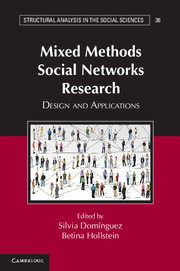Book contents
- Frontmatter
- Dedication
- Contents
- List of Tables
- List of Figures
- Contributors
- Foreword
- Acknowledgments
- Part I General Issues
- Part II Mixed Methods Applications
- Part III New Methodological Approaches Used in Mixed Methods Designs
- 9 Fuzzy-Set Analysis of Network Data as Mixed Method
- 10 Reconstructing Social Networks through Text Analysis
- 11 Giving Meaning to Social Networks
- 12 Simulating the Social Networks and Interactions of Poor Immigrants
- Index
- References
12 - Simulating the Social Networks and Interactions of Poor Immigrants
Published online by Cambridge University Press: 05 July 2014
- Frontmatter
- Dedication
- Contents
- List of Tables
- List of Figures
- Contributors
- Foreword
- Acknowledgments
- Part I General Issues
- Part II Mixed Methods Applications
- Part III New Methodological Approaches Used in Mixed Methods Designs
- 9 Fuzzy-Set Analysis of Network Data as Mixed Method
- 10 Reconstructing Social Networks through Text Analysis
- 11 Giving Meaning to Social Networks
- 12 Simulating the Social Networks and Interactions of Poor Immigrants
- Index
- References
Summary
Introduction
In social science disciplines the term “mixed methods” usually refers to studies that rely on a mix of qualitative and quantitative methods: on one hand, techniques that rely on small samples and seek to gain an in-depth understanding of a particular situation and the meanings individuals attach to it, and on the other, techniques based on randomized samples that permit the detection of patterns and create generalizable results. In this chapter we propose a different kind of “mixed method” analysis: one that incorporates data generated through qualitative techniques of participant observation and in-depth interviewing with agent-based modeling. The data of interest are the social networks of a local community of Salvadoran immigrants, and we base computer simulations of the networks on an earlier qualitative study by one of the authors. In order to capture the dynamics of the immigrants’ social network, describe reciprocity between actors, and understand how information affects access to resources, we use a sequential exploratory design, which, as Hollstein notes in the introduction to this volume, helps to explain conditions under which certain patterns take place and the consequences they can have. We start with qualitative observations that then inform computer simulations that generate data. The qualitative study shows how expectations of reciprocity can weaken social networks in poor communities, and the computer simulations show how adjusting the social cost of failing to reciprocate affects the density of the social networks. Thus, our chapter highlights a fundamental aspect for mixed methods research – that is, the integration of analysis at key stages in the process. As Hollstein (this volume) observes, it is this integration, in contrast to simply combining data or analyses, that is key to mixed methods studies. Also, importantly, the use of computer simulations allows the researcher to conduct experiments in silica that are impossible in the real world, such as changing the economic environment or the weight of social costs. The qualitative study sheds light on social mechanisms, and computer experiments explore those mechanisms in situations other than the ones actually observed.
- Type
- Chapter
- Information
- Mixed Methods Social Networks ResearchDesign and Applications, pp. 336 - 356Publisher: Cambridge University PressPrint publication year: 2014
References
- 1
- Cited by

